Elements of Art Texture Elements of Art Texture for Kids
Have you ever looked at a painting from afar and seen a beautiful prototype, and and then when you looked at it from up shut all you saw were the paintbrush marks and textures on the sheet? Seemingly the painting took on another meaning altogether. Texture is everywhere we expect, and in this article, nosotros will discuss texture in art, what it is, forth with texture art examples.
Table of Contents
- 1 What Is Texture in Fine art?
- 2 The Two Types of Texture in Fine art
- 2.1 Visual Texture
- 2.2 Physical Texture
- 3 Describing Texture in Art
- 4 Summary of Texture in Art
- 5 Principles of Art – Farther Readings
- 6 Frequently Asked Questions
- 6.1 What Is Texture in Art?
- 6.2 What Are the Types of Texture in Art?
- 6.3 What Are the Elements of Art?
- half dozen.4 What Are the Principles of Art?
What Is Texture in Fine art?
The texture art definition comprises various meanings. Firstly, the concept and word, "texture" relates to the "surface quality" of an artwork. What does surface quality mean, yous might wonder? This is the surface of any artwork, be it a painting on a sail or the feel of a sculpture.
This brings us to some other of import word related to texture, and that is feeling.
The texture in painting or sculpture allows u.s. to feel the artwork, which tin feel smooth, crude, or have a sleeky or matte cease. Now, we won't get upward to any painting and beginning touching it to feel the texture to understand information technology and appoint with it; similarly, nosotros cannot always feel a sculpture.
 Particular of the Rape of Proserpina (1621) by Gian Lorenzo Bernini;Alvesgaspar, CC Past-SA iv.0, via Wikimedia Commons
Particular of the Rape of Proserpina (1621) by Gian Lorenzo Bernini;Alvesgaspar, CC Past-SA iv.0, via Wikimedia Commons
This leads u.s.a. to some other pregnant around the texture art definition, which is that information technology can be seen without beingness felt, in other words, nosotros tin run across when an object or painting is textured. The texture of any artwork tells u.s. what it is, and without it, it would be more of a shape than anything else. For example, retrieve of a painted apple or tree bark; if these objects lack texture, they might announced more spherical or like a vertical cavalcade.
Texture in painting is an of import part of what gives it life.
Texture in art forms part of the 7 elements of art, which is considered almost like the "building blocks" of an artwork. The seven elements of art include colour, line, shape, class, value, space, and texture. These give the artwork its character and are coupled with the principles of art.
The principles of art include remainder, emphasis, harmony, multifariousness, unity, dissimilarity, rhythm, movement, blueprint, repetition, proportion, and scale. These are virtually like rules or guidelines that let us to employ the elements correctly to create a composition that works or acts almost like a set of criteria information technology allows united states to analyze an artwork efficiently.
The Two Types of Texture in Art
In that location are two common types of texture in art, namely, visual, otherwise described equally "implied" or the "illusion" of texture, or physical, which nosotros can touch and see, these can either be on a two or three-dimensional surface. Texture in art gives the impression of a three-dimensional object, figure, or infinite. Information technology can create depth and enhance certain qualities like contrast, movement, rhythm, or accent.
Beneath, we discuss these two qualities in more detail and illustrate them from texture art examples.
Visual Texture
Visual texture is otherwise referred to as "implied" or giving the "illusion" of texture. This is commonly on a ii-dimensional, flat, surface similar a canvas, which we can run across. An example of this is if the paint is applied smoothly, just it gives the impression of textured subject matter.
Visual texture tin be achieved in a multitude of means allowing meaning freedom of expression. If it is a painting, the common fashion will be with paintbrushes or painting tools like a palette knife, a sponge, or any other form of applying paint.
The type of pigment utilized is also important; for instance, there are oils, acrylics, tempera, or watercolors. Each type of paint will provide a different effect, or texture, on the canvas, the latter of which is another important aspect to consider as canvases, or any other painting surface, volition take unlike textures dependent on what they are fabricated of.
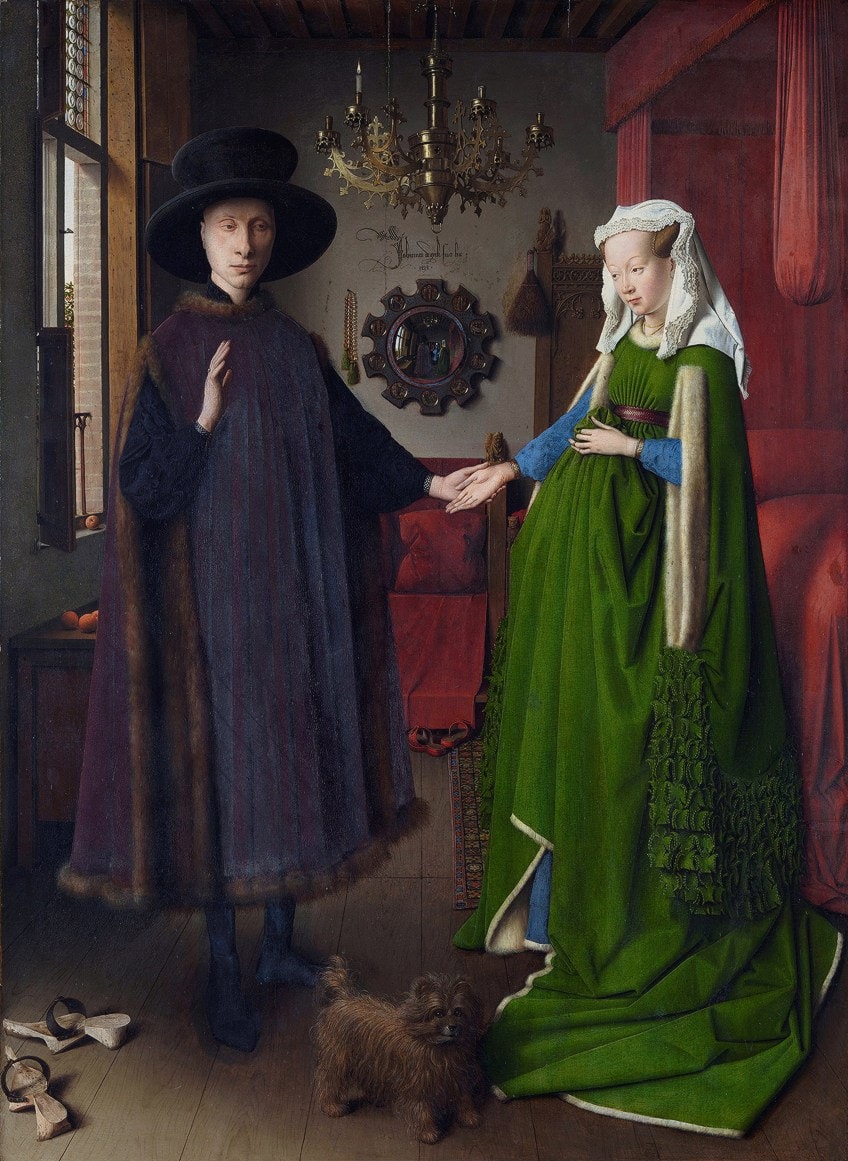 The Arnolfini Portrait (1434) by Jan van Eyck;Jan van Eyck, Public domain, via Wikimedia Eatables
The Arnolfini Portrait (1434) by Jan van Eyck;Jan van Eyck, Public domain, via Wikimedia Eatables
Additionally, there are different painting techniques that will inform the texture of the visual composition. Some of these, but non all, include impasto, which is a thick layering of paint on the surface; dry out brushing, as the name implies, a more often than not dry out paintbrush is utilized with paint on it; sfumato, which is a technique made famous by Renaissance artist Leonardo da Vinci; and pouring, which is a textured abstract art grade characteristic of Abstract Expressionism.
If drawing, which can be done with pencil, pen, or charcoal, amidst others, the type of paper will be an important contributor to the texture; artwork created through cartoon or sketching will likewise appear textured if various techniques are applied.
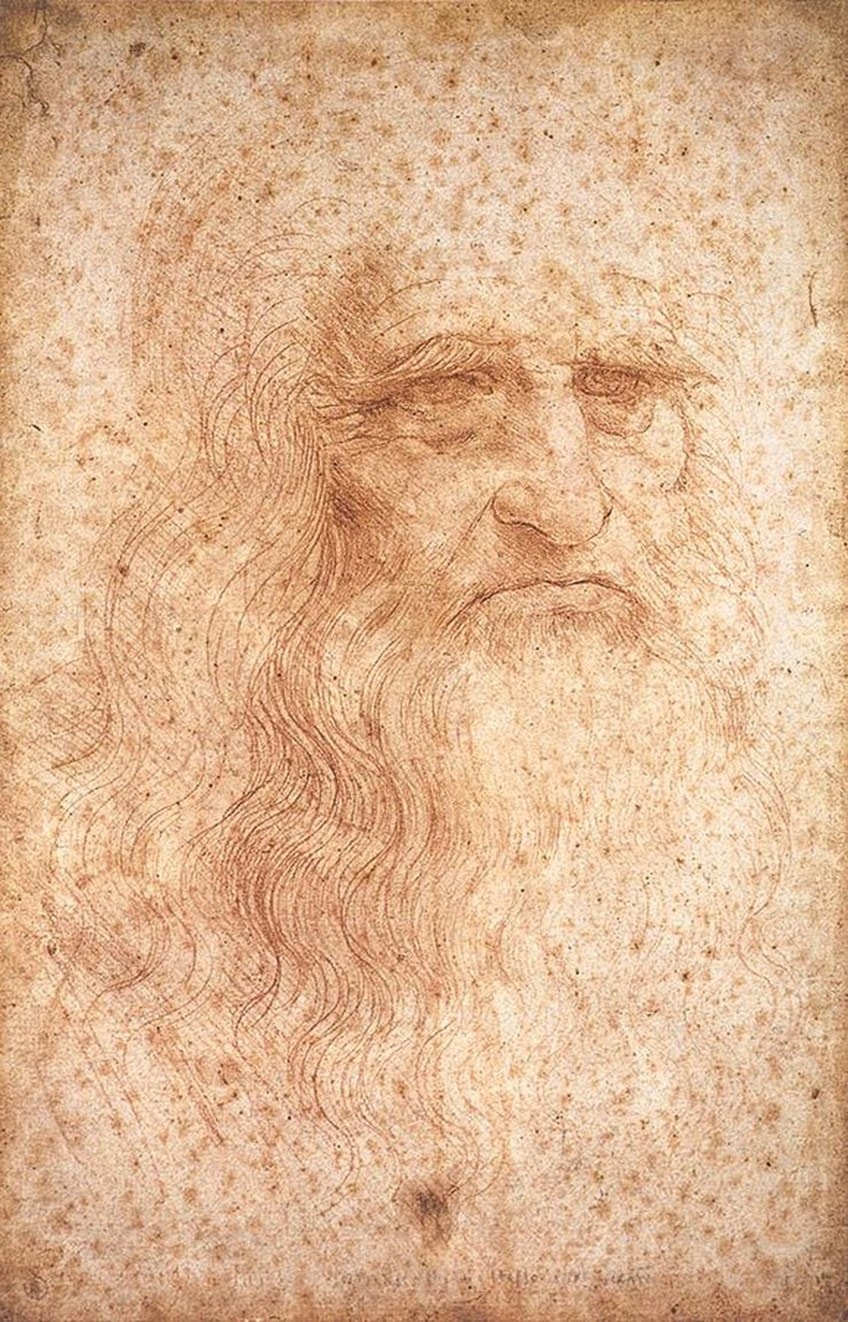 Portrait of a man in red chalk (c. 1510), a presumed self-portrait of Leonardo da Vinci;Leonardo da Vinci, Public domain, via Wikimedia Eatables
Portrait of a man in red chalk (c. 1510), a presumed self-portrait of Leonardo da Vinci;Leonardo da Vinci, Public domain, via Wikimedia Eatables
Some of these techniques include the common hatching and/or cross-hatching, which consist of lines parallel to one another and crossing one another; stippling, which consists of dots; scribbling, which is a more random application of lines or scribbles, and shading, which can be washed with either your finger or a tissue newspaper to create the desired upshot.
There are seemingly countless techniques that will create different textured effects in a limerick. Nosotros volition see these techniques in a variety of examples all throughout art history. As we mentioned higher up, Leonardo da Vinci pioneered painting techniques like sfumato, which we see in his famous painting titled Mona Lisa (c. 1503 – 1506).
 Portrait of Mona Lisa del Giocondo (1503-1506) past Leonardo da Vinci;Leonardo da Vinci, Public domain, via Wikimedia Commons
Portrait of Mona Lisa del Giocondo (1503-1506) past Leonardo da Vinci;Leonardo da Vinci, Public domain, via Wikimedia Commons
The sfumato technique gives the impression of a smooth texture specially when pare is depicted. Dissimilar paint colors or tones are composite with ane another in such a fashion that information technology produces a smoothed or "softened" effect, sometimes described equally "blurred" likewise.
This can exist where the colors change in tone, and information technology does not leave whatever traces of the edges or outlines of the subject matter.
Another example includes da Vinci'southward Virgin of the Rocks (1483-1486) depicting the 2 infants, Jesus Christ and John the Baptist, Mother Mary, and Uriel, an archangel. Here, nosotros see texture depicted equally smooth and fair skin tones.
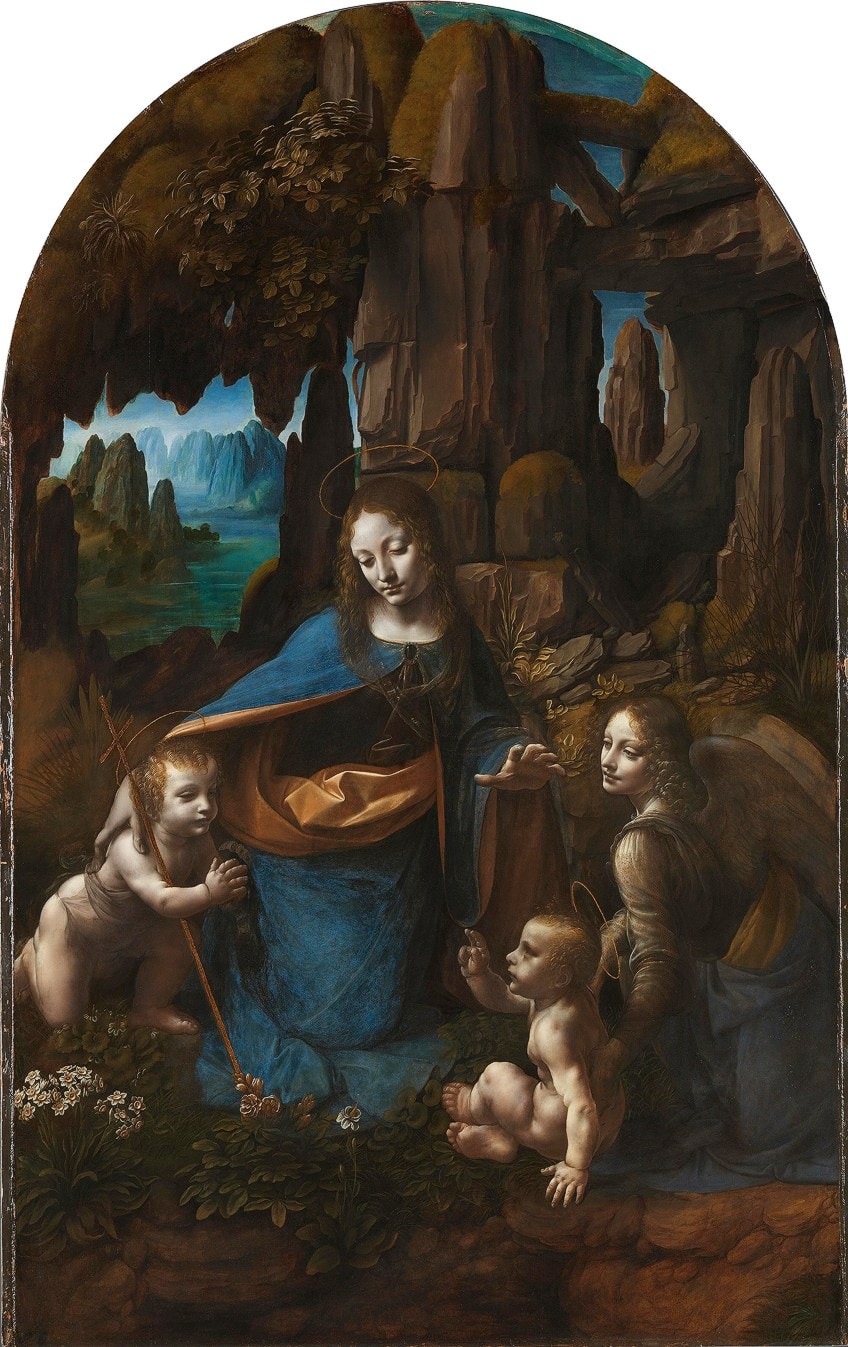 Virgin of the Rocks (1483-1486) by Leonardo da Vinci; Leonardo da Vinci and workshop, Public domain, via Wikimedia Commons
Virgin of the Rocks (1483-1486) by Leonardo da Vinci; Leonardo da Vinci and workshop, Public domain, via Wikimedia Commons
Other well-known Renaissance artists like Raphael and Giorgione also utilized the sfumato technique. For example, Raphael'due south The Sistine Madonna (1512-1513) and Giorgione'south Youth Holding an Arrow (c. 1500) both depict the figures' peel as smoothen.
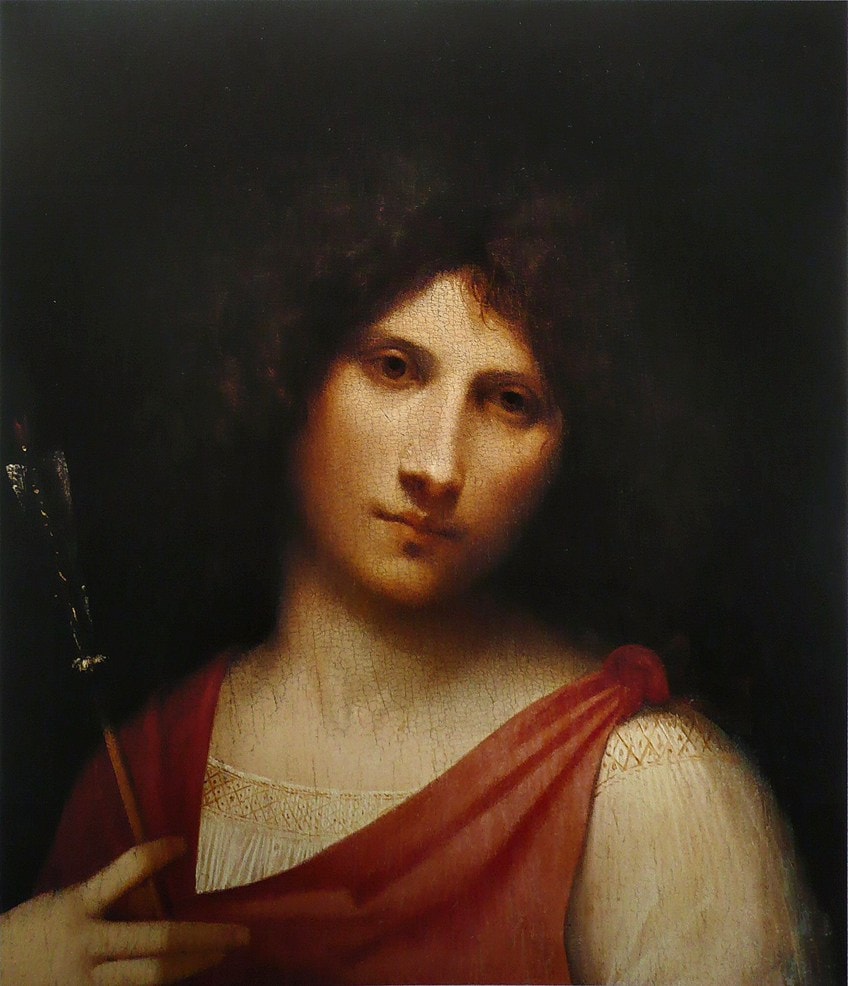 Youth Property an Arrow (c. 1500) by Giorgione;Giorgione, Public domain, via Wikimedia Commons
Youth Property an Arrow (c. 1500) by Giorgione;Giorgione, Public domain, via Wikimedia Commons
The skillful rendering of texture, artwork including clothing like robes, defunction, bedding, as well as furs, metals, and jewels, among others, is a prominent feature when looking at Renaissance art. The field of study matter was realistically portrayed, this realism was emphasized through texture in elements of art.
 The Sistine Madonna (1512-1513) by Raphael; Raphael, Public domain, via Wikimedia Eatables
The Sistine Madonna (1512-1513) by Raphael; Raphael, Public domain, via Wikimedia Eatables
Additionally, the visual texture was masterfully employed by artists from the Dutch Withal Life genre of paintings during the 16th, 17thursday, and 18th centuries. Examples include the Dutch Golden Age painter Pieter Claesz, who was a pioneer in what was known equally ontbijtjes pieces, or "breakfast pieces".
His painting However Life (c. 1625) provides the perfect illusion of a tabular array setting and all its accouterments; a cut-open pie, various biscuits, breadstuff, nuts, and olives, a pocketknife, a spoon, silver plates, and goblets filled with what appears to be wine.
At that place is hyperrealism near this painting and its objects, particularly the lustrous qualities of the glasses and argent, which appear smooth, and the rougher qualities of the other food items like the bread and pie.
 Still Life (c. 1625) past Pieter Claesz;Pieter Claesz, Public domain, via Wikimedia Commons
Still Life (c. 1625) past Pieter Claesz;Pieter Claesz, Public domain, via Wikimedia Commons
Physical Texture
Physical texture in art points to the physical feeling of artwork, something that has tactile qualities. This tin be a sculpture or a painting on which the paint has been thickly applied, like the impasto technique, or information technology tin be a sculpture fabricated from any material like bronze, woods, marble, or even stainless steel.
A famous example of how concrete texture can create a awareness and illusion of something is Jeff Koons' Balloon Dog (1994 – 2001), including several of his other large sculptures, which appear like inflated balloons. These sculptures are made from stainless steel, inviting usa to want to impact information technology and experience for ourselves whether information technology is in fact a existent larger-than-life-sized airship.
Another case is thickly applied paint to denote a textured subject area matter, for instance, the bark of a tree, a pool of h2o, or tall stalks of grass, as we see in Joan Eardley's texture artwork Seeded Grasses and Daisies, September (1960). This painting is a combination of textured abstract art that also becomes the subject matter.
If nosotros look at art history after the Renaissance and the evolution of the Modern era, artists felt more aware of expressing their inner worlds and the fleeting world effectually them.
New painting techniques were utilized to evoke emotions and ideas. Impressionist and Expressionist artists became famous for the way they utilized their paints and textured abstruse art resulted. Famous texture art examples include those of the Impressionist Claude Monet, who sought to depict the earth around him, almost like taking a photograph, en plein air or outdoor style. Using colors and texture, he gave us beautiful renderings of rays of sunlight and shade, for example, Impression, Sunrise (1872) or Sunrise, The Ocean (1873).
 Impression, Sunrise (1872) by Claude Monet;Claude Monet, Public domain, via Wikimedia Eatables
Impression, Sunrise (1872) by Claude Monet;Claude Monet, Public domain, via Wikimedia Eatables
In both higher up-mentioned paintings, Monet depicts the rays of sunlight on the sea's surface in curt, choppy, and textured, brushstrokes; most of his paintings are created this manner. This adds more than expression and feeling to the artwork versus a painting that is created with long, regular, and precise brushstrokes.
We will see these types of brushstrokes and textures in Vincent van Gogh'due south artworks too, such equally in the famous "The Starry Nighttime" (1889) or his "Cocky Portrait" (1889).
He created texture not only through a thicker application of paint but also utilizing swirling shapes, which gave the composition a different meaning beyond what is real, for example, the sky in The Starry Dark painting is depicted in rhythmic swirls, which lead us to feel more nigh it than it simply being a nighttime sky.
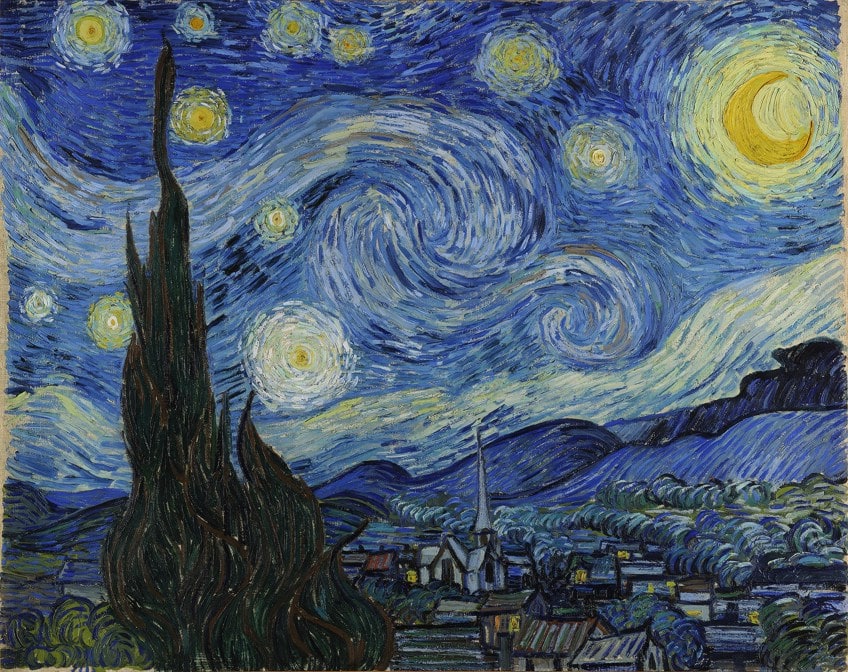 The Starry Night (1889) by Vincent van Gogh; Vincent van Gogh, Public domain, via Wikimedia Eatables
The Starry Night (1889) by Vincent van Gogh; Vincent van Gogh, Public domain, via Wikimedia Eatables
Other artists like the Romanticist J.W.Chiliad Turner, combined colors, lines, and textures to create ambient compositions. In the famous oil on sheet Rain, Steam and Speed – The Great Western Railway (1844) Turner depicted the ideas of speed from the train and the elements of nature similar rain in a flurry of thick and thin lines with various painting techniques.
 Pelting, Steam and Speed – The Not bad Western Railway (1844) past J. M. Due west. Turner;J. M. W. Turner, Public domain, via Wikimedia Commons
Pelting, Steam and Speed – The Not bad Western Railway (1844) past J. M. Due west. Turner;J. M. W. Turner, Public domain, via Wikimedia Commons
Describing Texture in Art
Texture can be described in many ways and for any artist, art historian, or fine art enthusiast some descriptive words will come in useful when exploring texture in elements of fine art. We already know the more common words like smooth and rough, beneath are a few others that fall into similar categories.
| Smooth | Rough | Cut |
| Soft, glossy, shiny, lustrous, cogitating, matte, silken, sleek, satiny, downy, leathery, furry, velvety, feathery, woolly, wrinkled. | Hard, coarse, raised, prickly, bristly, wiry, stony, frosted, glazed. | Scratched, sheared, incised, etched, engraved, chiseled, chipped, carved. |
Summary of Texture in Fine art
| Blazon of Texture | Characteristics | Texture artwork instance |
| Visual texture ("Implied" or "Illusionistic") | Texture that we can meet, but not physically feel. Information technology is commonly on a two-dimensional surface and gives the idea of texture or the illusion of texture. | Mona Lisa (c. 1503 – 1506) past Leonardo da Vinci Notwithstanding Life (c. 1625) by Pieter Claesz |
| Physical texture | Texture with tactile qualities, that we can experience, usually this is more three-dimensional similar raised paint on a flat canvas or a sculpted artwork. | Balloon Dog (1994 – 2001) by Jeff Koons The Starry Night (1889) by Vincent van Gogh |
Principles of Art – Further Readings
- Principles of Art primary article
- Movement in Art
- Accent in Art
- Unity in Art
- Rhythm in Art
- Proportion in Art
- Balance in Art
- Harmony in Art
In the commodity to a higher place, we looked at texture and its function as one of the elements of art. It can be applied in a myriad of media, for example painting like oil colors, acrylics, watercolors, drawing like pen and pencil, as well every bit sculpture, which can be anything from stone to steel. At that place are also diverse techniques bachelor that create different textures. We also explored the 2 primary types of texture, namely, visual, and physical texture, each with its ain unique characteristics, whether it is illusionistic or real to the touch. Whether it is a draped dress, a bristly brush, a sleek slither of sunlight, texture can be molded past the other elements of art like color, shape, form, and line, embossing the pregnant of the visual composition.
Ofttimes Asked Questions
What Is Texture in Art?
Texture is one of the elements of art and relates to the "surface quality" of an artwork, whether a painting, drawing, sculpture, photo, installation, or graphic art. It tin can exist created through numerous techniques and media to enhance the subject field matter and give it meaning.
What Are the Types of Texture in Art?
In that location are two chief types of texture in art, namely, visual, implied, or illusionistic, which can be seen on a two-dimensional surface; and concrete texture, which has tactile qualities and can exist felt on either a 2 or three-dimensional surface.
What Are the Elements of Art?
The elements of art are color, line, value, form, shape, space, and texture, these are utilized as visual tools to create artistic compositions. They can be practical post-obit various principles of fine art to create expressive, abstract, realistic, or whatever other form of artwork.
What Are the Principles of Art?
The principles of art are, namely, residue, harmony, unity, variety, movement, rhythm, proportion, calibration, emphasis, dissimilarity, repetition, and blueprint. These piece of work in conjunction with the vii elements of fine art.
Source: https://artincontext.org/texture-in-art/
0 Response to "Elements of Art Texture Elements of Art Texture for Kids"
Postar um comentário